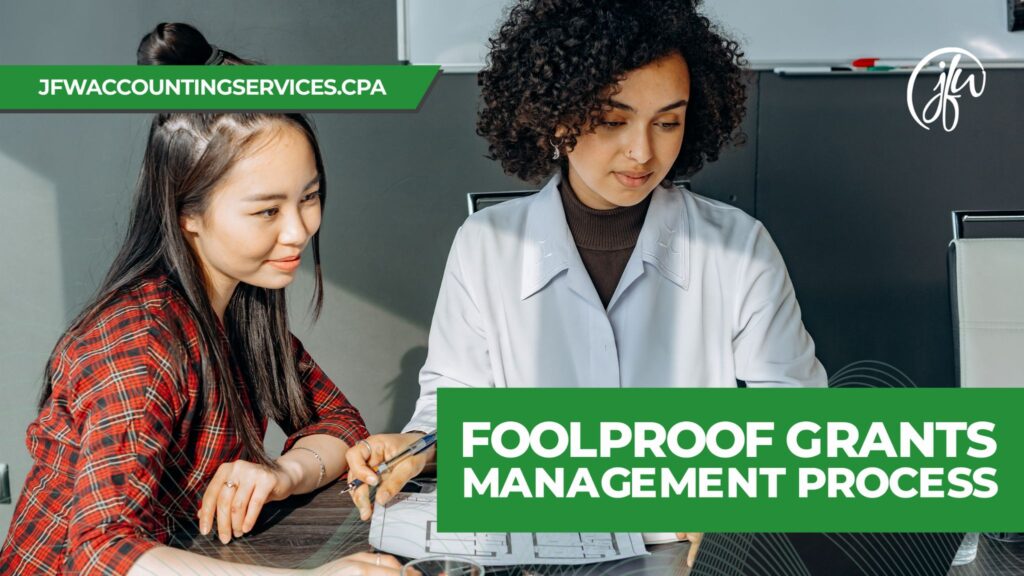Many nonprofits rely on revenue from grants to fund their missions, but managing grant transactions can be daunting. In this article, we discuss grant management, the steps in the grant management process, and provide an easy-to-use checklist to ensure your nonprofit organization stays on track with the grant management process.
What Is Grant Management?
Grant management is a term used to describe the process of seeking and receiving funding through grants. When nonprofit organizations administer grant proposals, apply for grants, process grant applications, and prioritize proposals, they are working within the grant lifecycle. The management of the grant lifecycle involves processing and organizing federal funding opportunities as well as tracking and reporting on eligibility requirements.
Also included in the lifecycle of grants for nonprofits that rely on those funds is the dedicated person, department, or external consultant that handles grant writing, or the preparation of grant proposals.
The Grant Management Process
The grant management process can be broken down into three parts, or phases: pre-award, award, and post-award.
Pre-Award
The pre-award phase in the grant management lifecycle can be the most overwhelming part of the process for even the most seasoned organization leader. Before getting started with the three-step pre-award phase of the grant lifecycle it is a good idea to document the organization’s grant objectives for clarification and reference.
The objective should include basic information about the nonprofit including the purpose for seeking funds, revenue projections and financial health, and the number of volunteers and programs.
Planning
The first step in the pre-award phase of the grant management process is grant planning. The planning phase should include basic information about the nonprofit as well as the purpose for seeking funds. Document revenue projections, financial health, and the number of volunteers and programs.
Once the organization’s objectives are clear, the search for funding opportunities that match your organization’s needs can begin.
Opportunity
In recent years, the most common method of finding grants is the internet. Many grant seekers find grants that match their organizational goals by using a grant database or consulting with a nonprofit expert.
Application
Grants are often time-sensitive, so once your organization has narrowed down the list of possibilities the application process should promptly begin. Some organizations hire grant writers to complete proposals and others complete the grant application in-house based on the information given with the grant information.
Award
The award phase of the grant lifecycle occurs when the Grantmaker selects and notifies grantees. Along with notification of the awarded funding, grantees are given an agreement to review that lists the terms and conditions required to remain eligible.
Every grant has unique conditions for grantees, which are set by the grantor and depend on the type and amount of the awarded grant. The agreement must be signed by all parties to initiate funding.
Post-Award
Once a grant has been awarded and the paperwork is finalized, there are two parts to the post-award phase. This part of the process happens internally at the receiving organization.
Execution
The grant execution phase includes receipt of funds from the granting agency and application of the revenue to its intended purpose, program, or project.
Closeout
Closing out the grant is the final phase of the grant management process, and it occurs once all funds have been applied. A grant closeout will require the funds to be tracked as well as some information about the impact the funds had on the organization’s members and community.
Grant Management Checklist
To simplify the grant management process, it is a smart idea to create a customized grant management checklist. While some steps in the checklist will depend on your nonprofit’s needs, the following checklist can serve as a template.
___ Document information in the grant objective including details about revenues, programs, budgets, cashflow projections, staff, and volunteers.
___ Search grant databases or work with a grant matching service to find funding opportunities and review grant eligibility requirements.
___ Apply for relevant grants through a database or prepare a written grant proposal.
___ Execute the application of funds to the organization’s mission.
___ Close out the grant by recording the financial details and results of the funding. Store the information in the organization’s accounting software for future reference.
Bottom Line
Grants are a major source of revenue for nonprofit organizations in every industry. Although the grant management process can seem overwhelming, following the checklist above will help the process move along smoothly. Working with an accounting and financial management software or outsourced expert is one way to simplify and expedite the process.
If you’re ready to take your organization’s mission to the next level with a revised grant management process or nonprofit customized software, reach out to JFW Accounting Services today.

Jo-Anne Williams Barnes, is a Certified Public Accountant (CPA) and Chartered Global Management Accountant (CGMA) holding a Master’s of Science in Accounting (MSA) and a Master’s in Business Administration (MBA). Additionally, she holds a Bachelor of Science (BS) in Accounting from the University of Baltimore and is a seasoned accounting professional with several years of experience in the field of managing financial records for non-profits, small, medium, and large businesses. Jo-Anne is a certified Sage Intacct Accounting and Implementation Specialist, a certified QuickBooks ProAdvisor, an AICPA Not-for-Profit Certificate II holder, and Standard for Excellence Licensed Consultant. Additionally, Jo-Anne is a member of American Institute of Certified Public Accountant (AICPA), Maryland Association of Certified Public Accountants (MACPA), and Greater Washington Society of Certified Public Accountants (GWSCPA) where she continues to keep abreast on the latest industry trends and changes.

